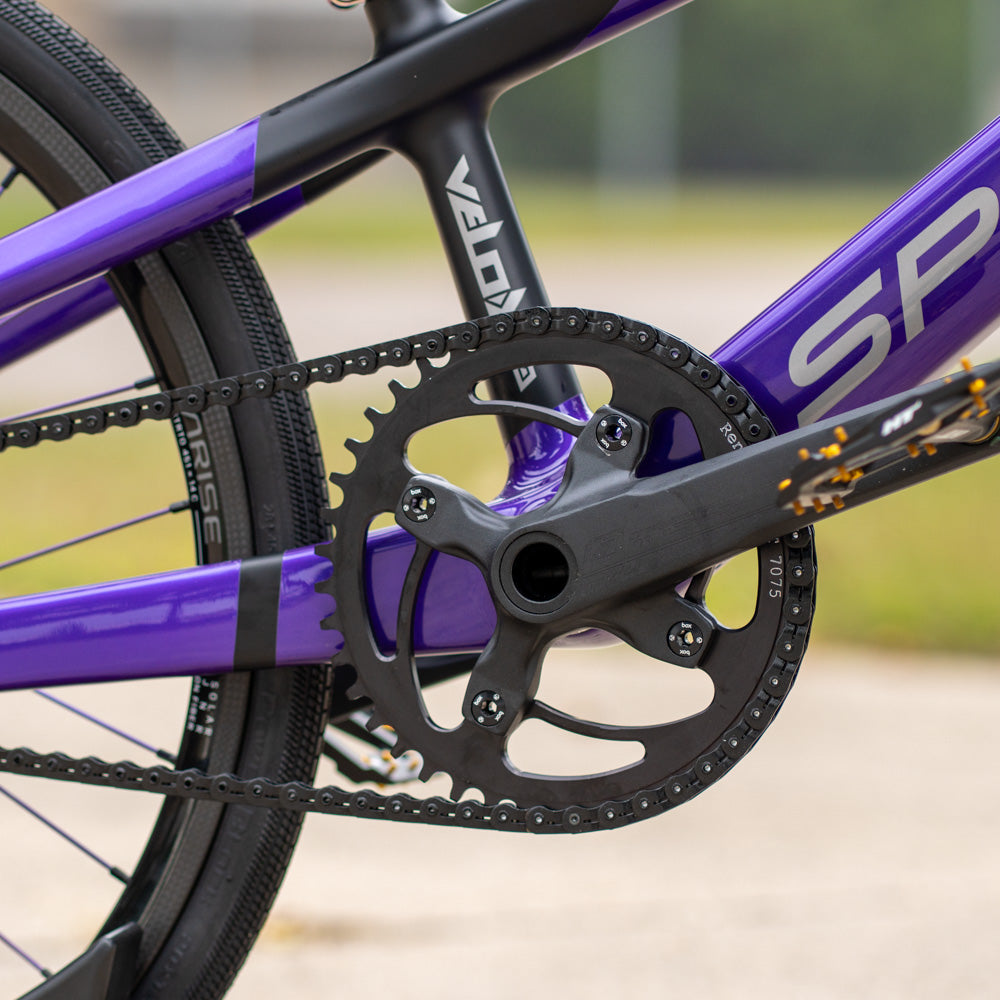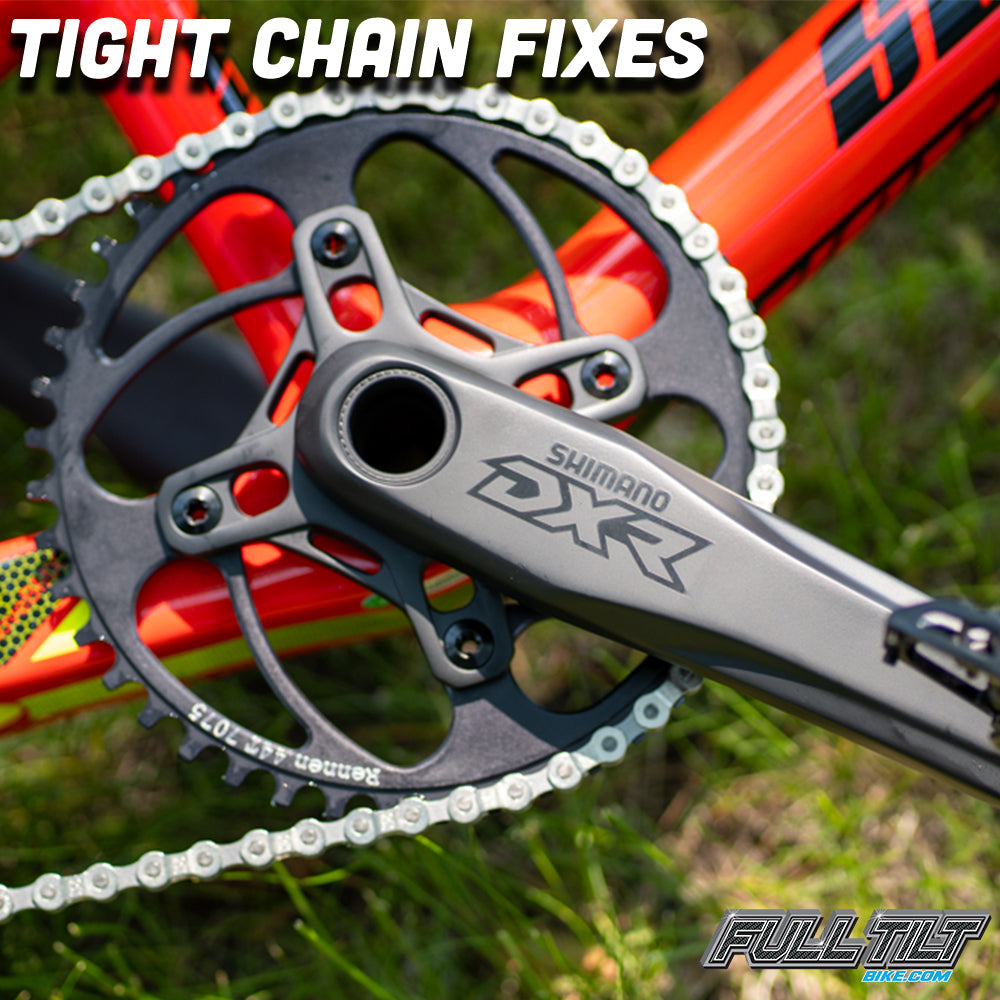Ever wondered whether a harder gear really makes you faster in BMX, you’re not alone. In this test, Jonnie and Race compare multiple gear ratios to see where acceleration starts to fall off and which rollout feels fastest for each rider.
Spoiler: there isn’t one “golden” gear for everyone. Your training, cadence, and track all matter.
What We Tested
- Gearing: 43/16, 44/16, 45/16, 47/16, 49/16
- Crank length: 175 mm
- Tire: Tioga PowerBlock 20 x 1.75
- Metric: 40-foot timed sprints (start-like acceleration)
- Goal: Find the tipping point at which quick acceleration to 40ft dies off
Quick Terms
- Rollout: How far the bike travels per pedal revolution. Higher rollout = harder gear.
- Acceleration window: First 40 feet off the line; simulates the gate start sequence of sprinting to the first jump.
- Chainring: The larger ring within the drivetrain that’s attached to the crank arm. Features a varying number of teeth.
Key Results at a Glance
- Race was fastest and most consistent on 43/16 (about 53.5 rollout).
- Jonnie was fastest on 44/16 (mid-54 rollout).
- Moving to 45/16 and beyond (56–61 rollout) hurt 40-foot acceleration for Race, but Jonnie could still put down some fast individual times, with more effort and less repeatability.
Big takeaway: harder isn’t always better for starts. Consistency and repeatability is what wins race day.
Gear-by-Gear Highlights
43/16 (about 53.5 rollout)
- Race: Best single time 2.01; best average 2.02. Most efficient and repeatable.
- Jonnie: Solid but not his peak.
44/16 (about 54.7 rollout)
- Race: Slightly slower on average than 43/16.
- Jonnie: Personal best average here around 1.93–1.95. Felt “right” for his strength and cadence.
45/16 (about 56.0 rollout)
- Race: Noticeable drop in acceleration (times around 2.10–2.16). Fatigue showed.
- Jonnie: Could still hit mid-1.9s, but effort and form had to be perfect. Not sustainable across a race day.
47/16 (about 58 rollout)
- Race: 2.09–2.10 range, inconsistent with fatigue.
- Jonnie: Could punch high 1.9s, but form became hard to control. Patience on first pedals was key.
49/16 (about 61 rollout)
- Race: 2.14–2.18 range. Very tough to get on top of the gear at 40 feet.
- Jonnie: Could barely dip into the 1.9s, but it took everything and wasn’t practical for gates or repeat sprints.
What This Means for Your Racing
- There is no universal best ratio. The right gear depends on your strength, cadence, and training.
- If you’re explosive and train sprints often, you may run a slightly bigger gear without losing start speed.
- If you don’t sprint or lift consistently, a lighter gear will likely give you better acceleration and repeatability.
- Race-day reality: if you’re getting pinched at 30 feet, top speed at 200 feet won’t save the moto. First straight performance should be a top priority when developing a race set up.
How to Find Your Sweet Spot (Simple Process)
- Pick a baseline: Start with a common you like or something you’ve had success on. Start near 43/16 on 175s if you’re unsure.
- Test in sets: Do 5–10 timed sprints at 40 ft. Track best and average.
- Step up one tooth: Repeat the test at 44/16. Compare averages, not just best times.
- Push range once: Try 45/16 to feel the ceiling. Note form, fatigue, and consistency.
- Confirm results: Repeat at your home track or other tracks that offer timing. Add checkpoints at 60, 100, and 200 ft if possible to see where each gear shines.
- Choose the gear that gives you the best average start and repeatability, not just a one-off hero time.
Training Tip: Over-Geared Sprints Work
- Use bigger rollout (56–61) for training sprints on flat ground.
- Riding bigger gears forces proper sprint mechanics and builds strength similar to lifting heavier weights in the gym.
- Focus on tall posture, smooth first two pedals, and bracing your core.
- This builds specific strength and improves your first-pedal mechanics.
- Save lighter race gear for gates and full laps, where repeatability matters.
Common Mistakes to Avoid
- Jumping two teeth for racing because it felt fast once in training.
- Chasing top speed at the expense of your first 30–40 feet.
- Ignoring averages. One PR could win you a lap; but consistency gets you through the rounds and into that main event.
- Rushing your first two pedals when the gear gets bigger. Be patient, tall, and keep good form.
FAQ
Is 47/16 or 49/16 a realistic race gear?
- For most riders and most tracks, no. They can be useful for over-geared training, but they cost you too much at the start. These gears were only included to showcase extreme ends of the spectrum.
What matters more, front teeth or rear teeth?
- The ratio and rollout is all that really matters. You can achieve similar rollouts with different gearing combos. Test what feels smooth and repeatable. But the overall rollout is all that should really matter.
Should I change cranks first or chainring?
- Start with chainring changes (1 tooth at a time). If you’re consistently spun-out or bogged-down across multiple tracks, consider crank length next. You can read more about crank length here.
Got A Burning Question?
Don't fret, we're here to help! Reach out to us via our contact page with any questions not answered here. Full Tilt Bike Co. is a Racer owned and operated race shop, so we don't just sell products, we race them too! Send an email to info@fulltiltbike.com to get in-touch with a team member and they can help guide you through the process of selecting essential drivetrain components.


